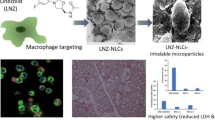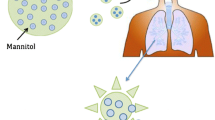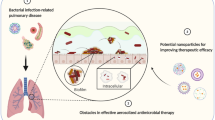Abstract
Purpose
Traditional polymeric nanoparticle formulations for prolonged local action during inhalation therapy are highly susceptible to muco-ciliary clearance. In addition, polymeric carriers are typically administered in high doses due to finite drug loading. For toxicological reasons, these carriers and their degradation byproducts are undesirable for inhalation therapy, particularly for chronic use, due to potential lung accumulation.
Methods
We synthesized a novel, insoluble prodrug (MRPD) of a time-dependent β-lactam, meropenem, and formulated MRPD into mucus-penetrating crystals (MRPD-MPCs). After characterizing their mucus mobility (in vitro) and stability, we evaluated the lung pharmacokinetics of intratracheally-instilled MRPD-MPCs and a meropenem solution in guinea pigs.
Results
Meropenem levels rapidly declined in the lungs of guinea pigs receiving meropenem solution compared to those given MRPD-MPCs. At 9 h after dosing, drug levels in the lungs of animals that received meropenem solution dropped to 12 ng/mL, whereas those that received MRPD-MPCs maintained an average drug level of ≥1,065 ng/mL over a 12-h period.
Conclusions
This work demonstrated that the combination of prodrug chemistry and mucus-penetrating platform created nanoparticles that produced sustained levels of meropenem in guinea pig lungs. This strategy represents a novel approach for sustained local drug delivery to the lung without using encapsulating matrices.





Similar content being viewed by others
Abbreviations
- CF:
-
Cystic fibrosis
- C max :
-
Peak concentration
- CVM:
-
Cervicovaginal mucus
- HLMs:
-
Human lung microsomes
- HPLC:
-
High-performance liquid chromatography
- LML:
-
Luminal mucus layer
- MIC:
-
Minimum inhibitory concentration
- MPC:
-
Mucus-penetrating crystal
- mPEG:
-
Methoxy poly(ethylene) glycol
- MPP:
-
Mucus-penetrating particle
- MRPD :
-
Meropenem prodrug
- MRPD-MPC :
-
MRPD formulated as a mucus-penetrating crystal
- n:
-
Particle population
- PCL:
-
Periciliary layer
- PDI:
-
Polydispersity index
- PK:
-
Pharmacokinetics
- PS:
-
Polystyrene
- S :
-
Solubility
- Vmean :
-
Mean ensemble velocity
References
Loira-Pastoriza C, Todoroff J, Vanbever R. Delivery strategies for sustained drug release in the lungs. Adv Drug Deliv Rev. 2014;75:81–91.
Olsson B, Bondesson E, Borgström L, Edsbäcker S, Eirefelt S, Ekelund K, et al. Pulmonary drug metabolism, clearance, and absorption. In: Smyth HDC, Hickey AJ, editors. Controlled pulmonary drug delivery. New York: Springer; 2011. p. 21–50.
Jones RM, Neef N. Interpretation and prediction of inhaled drug particle accumulation in the lung and its associated toxicity. Xenobiotica. 2012;42(1):86–93.
Wolff RK, Griffith WC, Jr., Cuddihy RG, Snipes MB, Henderson RF, Mauderly JL, et al. Modeling accumulations of particles in lung during chronic inhalation exposures that lead to impaired clearance. Health Phys. 1989;57 Suppl 1 (Copyright (C) 2015 U.S. National Library of Medicine.):61–7; discussion 7–8.
Gehr P, Blank F, Rothen-Rutishauser BM. Fate of inhaled particles after interaction with the lung surface. Paediatr Respir Rev. 2006;7 Suppl 1:S73–5.
Schmid O, Moller W, Semmler-Behnke M, Ferron GA, Karg E, Lipka J, et al. Dosimetry and toxicology of inhaled ultrafine particles. Biomarkers. 2009;14 Suppl 1:67–73.
Ibrahim M, Garcia-Contreras L. Mechanisms of absorption and elimination of drugs administered by inhalation. Ther Deliv. 2013;4(8):1027–45.
Lai SK, Wang YY, Hanes J. Mucus-penetrating nanoparticles for drug and gene delivery to mucosal tissues. Adv Drug Deliv Rev. 2009;61(2):158–71.
Nance EA, Woodworth GF, Sailor KA, Shih T-Y, Xu Q, Swaminathan G, et al. A dense poly(ethylene glycol) coating improves penetration of large polymeric nanoparticles within brain tissue. Sci Transl Med. 2012;4:149ra119.
Suk JS, Kim AJ, Trehan K, Schneider CS, Cebotaru L, Woodward OM, et al. Lung gene therapy with highly compacted DNA nanoparticles that overcome the mucus barrier. J Control Release. 2014;178:8–17.
Yang M, Yu T, Wang YY, Lai SK, Zeng Q, Miao B, et al. Vaginal Delivery of paclitaxel via nanoparticles with non-mucoadhesive surfaces suppresses cervical tumor growth. Adv Healthc Mater. 2013.
Schopf LR, Popov AM, Enlow EM, Bourassa JL, Ong WZ, Nowak P, et al. Topical ocular drug delivery to the back of the eye by mucus-penetrating particles. Transl Vis Sci Technol. 2015;4(3):11.
Schopf L, Enlow E, Popov A, Bourassa J, Chen H. Ocular pharmacokinetics of a novel loteprednol etabonate 0.4% ophthalmic formulation. Ophthalmol Ther. 2014;3(1–2):63–72.
Baudy RB, Butera JA, Abou-Gharbia MA, Chen H, Harrison B, Jain U, et al. Prodrugs of perzinfotel with improved oral bioavailability. J Med Chem. 2009;52(3):771–8.
Maury J, Feray L, Perfetti P, Bertrand MP. A flexible, stereoselective dimethylzinc-mediated radical-anionic cascade: dramatic influence of additional Lewis acids. Org Lett. 2010;12(16):3590–3.
Popov A, Enlow EM, Bourassa J, Gardner CR, Chen H, Ensign LM, et al. Nanocrystals, compositions, and methods that aid particle transport in mucus. US Patent Application Publication. 2013; US20130323179.
Wang YY, Lai SK, Suk JS, Pace A, Cone R, Hanes J. Addressing the PEG mucoadhesivity paradox to engineer nanoparticles that “slip” through the human mucus barrier. Angew Chem Int Ed Engl. 2008;47(50):9726–9.
Viaene E, Chanteux H, Servais H, Mingeot-Leclercq MP, Tulkens PM. Comparative stability studies of antipseudomonal beta-lactams for potential administration through portable elastomeric pumps (home therapy for cystic fibrosis patients) and motor-operated syringes (intensive care units). Antimicrob Agents Chemother. 2002;46(8):2327–32.
Lai SK, O’Hanlon DE, Harrold S, Man ST, Wang YY, Cone R, et al. Rapid transport of large polymeric nanoparticles in fresh undiluted human mucus. Proc Natl Acad Sci U S A. 2007;104(5):1482–7.
Tang BC, Dawson M, Lai SK, Wang YY, Suk JS, Yang M, et al. Biodegradable polymer nanoparticles that rapidly penetrate the human mucus barrier. Proc Natl Acad Sci U S A. 2009;106(46):19268–73.
Boer F. Drug handling by the lungs. Br J Anaesth. 2003;91(1):50–60.
Fukasawa M, Sumita Y, Harabe ET, Tanio T, Nouda H, Kohzuki T, et al. Stability of meropenem and effect of 1 beta-methyl substitution on its stability in the presence of renal dehydropeptidase I. Antimicrob Agents Chemother. 1992;36(7):1577–9.
Hirota T, Nishikawa Y, Tanaka M, Igarashi T, Kitagawa H. Characterization of dehydropeptidase I in the rat lung. Eur J Biochem. 1986;160(3):521–5.
Cayston prescribing information. Available from: http://www.cayston.com/prescribing_info.html as of August, 2014.
Patel PR, Cook SE. Stability of meropenem in intravenous solutions. Am J Health Syst Pharm. 1997;54(4):412–21.
Teitelbaum AM, Meissner A, Harding RA, Wong CA, Aldrich CC, Remmel RP. Synthesis, pH-dependent, and plasma stability of meropenem prodrugs for potential use against drug-resistant tuberculosis. Bioorg Med Chem. 2013;21(17):5605–17.
Langer R. Polymer-controlled drug delivery systems. Acc Chem Res. 1993;26(10):537–42.
Cystic Fibrosis Foundation Patient Registry 2008 Annual Data Report. Bethesda: Cystic Fibrosis Foundation 2009.
Dales L, Ferris W, Vandemheen K, Aaron SD. Combination antibiotic susceptibility of biofilm-grown Burkholderia cepacia and Pseudomonas aeruginosa isolated from patients with pulmonary exacerbations of cystic fibrosis. Eur J Clin Microbiol Infect Dis. 2009;28(10):1275–9.
Maiz L, Giron RM, Olveira C, Quintana E, Lamas A, Pastor D, et al. Inhaled antibiotics for the treatment of chronic bronchopulmonary Pseudomonas aeruginosa infection in cystic fibrosis: systematic review of randomised controlled trials. Expert Opin Pharmacother. 2013;14(9):1135–49.
Turnidge JD. The pharmacodynamics of beta-lactams. Clin Infect Dis. 1998;27(1):10–22.
Oermann CM, Retsch-Bogart GZ, Quittner AL, Gibson RL, McCoy KS, Montgomery AB, et al. An 18-month study of the safety and efficacy of repeated courses of inhaled aztreonam lysine in cystic fibrosis. Pediatr Pulmonol. 2010;45(11):1121–34.
Sahm D. In vitro activity of doripenem. Clin Infect Dis. 2009;49 Suppl 1:S11–6.
Gibson RL, Retsch-Bogart GZ, Oermann C, Milla C, Pilewski J, Daines C, et al. Microbiology, safety, and pharmacokinetics of aztreonam lysinate for inhalation in patients with cystic fibrosis. Pediatr Pulmonol. 2006;41(7):656–65.
ACKNOWLEDGMENTS AND DISCLOSURES
The work described was partially supported by Award Number R43HL106899 from the National Heart, Lung and Blood Institute. The content is solely the responsibility of the authors and does not necessarily represent the official views of the National Heart, Lung and Blood Institute or the National Institutes of Health.
Author information
Authors and Affiliations
Corresponding author
Rights and permissions
About this article
Cite this article
Ong, W., Nowak, P., Cu, Y. et al. Sustained Pulmonary Delivery of a Water-Soluble Antibiotic Without Encapsulating Carriers. Pharm Res 33, 563–572 (2016). https://doi.org/10.1007/s11095-015-1808-x
Received:
Accepted:
Published:
Issue Date:
DOI: https://doi.org/10.1007/s11095-015-1808-x




